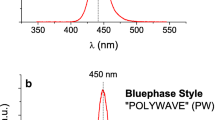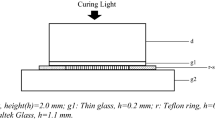Abstract
This in vitro study evaluated the influence of one halogen and two light-emitting diode (LED) curing units on the curing depth of a conventional hybrid and two translucent resin composites by measuring the Knoop microhardness. In the first part of the study, a conventional hybrid resin composite and three curing units (one halogen: 40 s polymerization time, two LEDs: 10 and 20 s) were used. Ten cylindrical resin composite samples were prepared for each curing unit and each polymerization time tested. After polymerization, the soft part of the samples was removed. The samples were embedded in a polyacrylic resin and separated in the middle towards the direction, top–bottom. On the section plane, Knoop microhardness measurements were performed every 1 mm, starting at 0.5 mm under the surface. In the second part of the study, two translucent resin composites and a conventional hybrid composite resin were cured with the three curing units, and the microhardness was measured as mentioned above. The difference between the curing units tested was found statistically significant (p = 0.0009), as well as the difference between the materials concerning curing depth (p = 0.0001). Both translucent materials achieved microhardness values equal to the 80% of the surface values, in depths 3.5–5.5 mm, depending on the curing units used.



Similar content being viewed by others
References
Aravamudhan K, Floyd CJ, Rakowski D, Flaim G, Dickens SH, Eichmiller FC, Fan PL (2006) Light-emtting diode curing light irradiance and polymerization of resin-based composite. J Am Dent Assoc 137:213–223
Campregher UB, Samuel SM, Fortes CB, Medina AD, Collares FM, Ogliari FA (2007) Effectiveness of second-generation light-emitting diode (LED) light curing units. J Contemp Dent Pract 8:35–42
Chen Y, Ferracane JL, Prahl SA. (2005) Quantum yield of conversion of the dental photoinitiator camphorquinone. Saratov fall meeting 2004: optical technologies in biophysics and medicine IV. In: Tuchin VV (ed) Proc SPIE vol 5771. pp 256–266
Chung KH (1990) The relationship between composition and properties of posterior resin composites. J Dent Res 69:852–856
Dunn WJ, Bush AC (2002) A comparison of polymerization by light-emitting diode and halogen-based light-curing units. J Am Dent Assoc 133:335–341
Ferracane JL (1985) Correlation between hardness and degree of convention during the setting reaction of unfilled dental restorative resins. Dent Mater 1:11–14
Hofmann N, Hugo B, Schubert K, Klaiber B (2000) Comparison between a plasma arc light source and conventional halogen curing units regarding flexural strength, modulus, and hardness of photoactivated resin composites. Clin Oral Investig 4:140–147
Jandt KD, Mills RW, Blackwell GB, Ashworth SH (2000) Depth of cure and compressive strength of dental composites cured with blue light emitting diodes (LEDs). Dent Mater 16:41–47
Jung H, Friedl KH, Hiller KA, Haller A, Schmalz G (2001) Curing efficiency of different polymerization methods through ceramic restorations. Clin Oral Investig 5:156–161
Knezevic A, Tarle Z, Meniga A, Sutalo J, Pichler G (2001) Degree of conversion and temperature rise during polymerization of composite resin samples with blue diodes. J Oral Rehabil 28:586–591
Lindberg A, Peutzfeldt A, van Dijken JW (2004) Curing depths of a universal hybrid and a flowable resin composite cured with a quartz tungsten halogen and light-emitting diode units. Acta Odontol Scand 62:97–101
Lindberg A, Peutzfeldt A, van Dijken JW (2005) Effect of power density of curing unit, exposure duration, and light guide distance on composite depth of cure. Clin Oral Investig 9:71–76
Magna RK, Charlton DG, Wakefield CW (1995) In vitro evaluation of a curing radiometer as a predictor of polymerization depth. Gen Dent 43:241–246
Martin FE (1998) A survey of the efficiency of visible light curing units. J Dent 26:239–243
Mills RW (1995) Blue light emitting diodes - another method of light curing. Br Dent J 178:169(Letter)
Mills RW, Jandt KD, Ashworth SH (1999) Dental composite depth of cure with halogen and blue light emitting diode technology. Br Dent J 186:388–391
Mills RW, Uhl A, Jandt KD (2002) Optical power outputs, spectra and dental composite depths of cure, obtained with blue light emitting diode (LED) and halogen light curing units (LCUs). Br Dent J 193:459–463
Park YJ, Chae KH, Rawls HR (1999) Development of a new photoinitiator system for dental light-cure composite resins. Dent Mater 15:120–127
Pilo R, Oelgiesser D, Cardash HS (1999) A survey of output and potential for depth of cure among light-cured composite. J Dent 27:235–241
Rodrigues Junior SA, Zanchi CH, Carvalho RV, Demarco FF (2007) Flexural strength and modulus of elasticity of different types of resin-based composites. Pesqui Odontol Bras 21:16–21
Ruyter IE (1985) Monomer systems and polymerization. In: Vanherle G, Smith DC (eds) Posterior composite resin dental restorative materials. Peter Szulc Publishing Co, Amsterdam, pp 109–136
Schneider LF, Consani S, Correr-Sobrino L, Correr AB, Sinhoreti MA (2006) Halogen and LED light curing of composite temperature increase and Knoop hardness. Clin Oral Investig 10:66–71
Stahl F, Ashworth SH, Jandt KD, Mills RW (2000) Light-emitting diode (LED) polymerization of dental composites: flexural properties and polymerization potential. Biomaterials 21:1379–1385
Uhl A, Michaelis C, Mills RW, Jandt KD (2004) The influence of storage and indenter load on the Knoop hardness of dental composites polymerized with LED and halogen technologies. Dent Mater 20:21–28
Uhl A, Sigusch BW, Jandt KD (2004) Second generation LEDs for the polymerization of oral biomaterials. Dent Mater 20:80–87
Vargas MA, Cobb DS, Schmit JL (1998) Polymerization of composite resins: argon laser vs conventional light. Oper Dent 23:87–93
Watts DC, Amer O, Combe EC (1984) Characteristics of visible-light-activated composite systems. Br Dent J 56:209–215
Watts DC, Amer OM, Combe EC (1987) Surface hardness determination in light-cured composites. Dent Mater 3:265–269
Witzel MF, Calheiros FC, Goncalves F, Kawano Y, Braga RR (2005) Influence of photoactivation method on conversion, mechanical properties, degradation in ethanol and contraction stress of resin-based materials. J Dent 33:773–779
Yoon TH, Lee YK, Lim BS, Kim CW (2002) Degree of polymerization of resin composites by different light sources. J Oral Rehabil 29:1165–1173
Author information
Authors and Affiliations
Corresponding author
Rights and permissions
About this article
Cite this article
Polydorou, O., Manolakis, A., Hellwig, E. et al. Evaluation of the curing depth of two translucent composite materials using a halogen and two LED curing units. Clin Oral Invest 12, 45–51 (2008). https://doi.org/10.1007/s00784-007-0142-z
Received:
Accepted:
Published:
Issue Date:
DOI: https://doi.org/10.1007/s00784-007-0142-z




